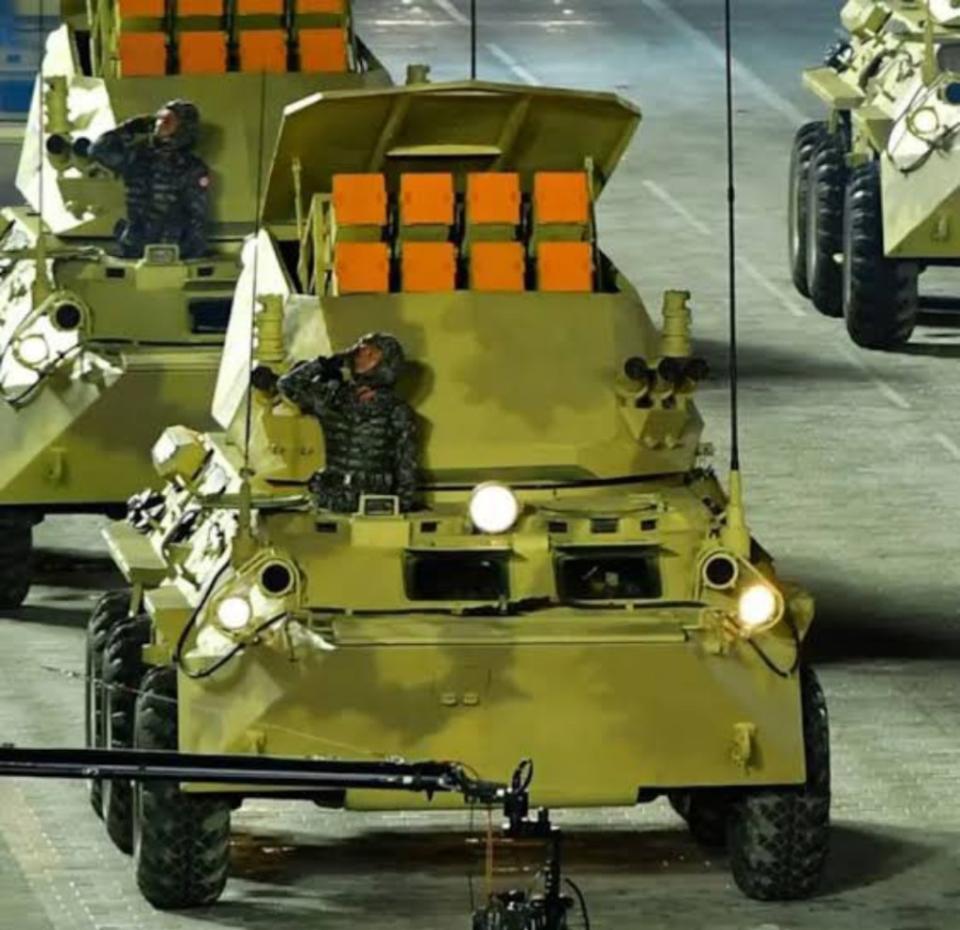Russia appears to have deployed a North Korean Bulsae-4 M-2018 Non-Line-Of-Sight (NLOS) long-range, self-propelled Anti-Tank Guided Missile (ATGM) system in Ukraine. A six-wheeled armored vehicle closely resembling that weapon system was recently spotted by Ukrainian aerial surveillance in the Kharkiv region near the Russian border, according to the KUP Telegram channel, which first posted an image of it. This would be the first known armored vehicle provided by Pyongyang to Moscow in a burgeoning relationship of convenience.
The Bulsae-4 has eight missile containers in a rotating turret mounted onto what Global Security said is a North Korean M-2010 armored personnel carrier hull. The container hatch cover and gap between the first and second set of wheels in the first photo below captured by Ukraine appear identical to those seen in the following two images, which are official North Korean photos.



The Bulsae-4’s NLOS missiles would add, at least on paper, a new stand-off capability to Russia’s anti-armor arsenal. Similar in function to Israel’s Spike NLOS and other variants and knockoffs, they allow for man-in-the-loop first-person control in flight. As a result, the missiles can also be launched and fly towards an area before being locked onto a target (lock-on after launch). That means the target wouldn’t even need to be in direct line-of-sight of the launcher and the missile can work around minor fluctuations in terrain and man-made obstacles. This offers the operators many new tactical possibilities, including hitting targets behind cover and even finding a target’s exact location after launch. The missile could even be diverted to another target midway through its flight. In general, these types of missiles have the ability to attack targets from above, which is usually a more vulnerable location than an armored front and sides.
The Ukrainian Militinaryi military website said the North Korean missile is guided by an electro-optical seeker combined with command guidance via fiber optic cable. That long line of fiber-optic cable spooled out behind the missile gives connectivity to the person controlling it. Militinaryi also suggests the North Korean NLOS missiles have a range of greater than 10 km (6 miles).
You can see an example of an Israeli-made Spoke NLOS below.


There have been previous reports of unspecified ATGMs heading from North Korea to Russia, but this appears to be the first time we have learned what kind. It is unclear when the Bulsae-4 system arrived, but it would be the latest in a range of weapons transferred from North Korea to Russia.
North Korea has already provided Russia with millions of artillery shells and dozens of short-range ballistic missiles. There are growing concerns that Russian expertise might be used to help with the further development of Pyongyang’s ballistic missiles, as well as other weapons and technologies.
The relationship between the two nations is going well beyond weaponry, as well. Last month, after they signed a mutual assistance pact, there was an unconfirmed report by a South Korean TV station that North Korea would send engineering troops to Ukraine to help the Russian fight there and rebuild areas of the country it occupies.
While this appears to be the first time a Bulsae-4 was seen in Ukraine, it may not be the first time it was used. Its capabilities possibly fit with an attack earlier this year on a Ukrainian 155mm AS-90 howitzer, which you can see in the video below. The War Zone cannot independently verify this claim.
Destruction of Ukrainian 155mm AS-90 howitzer by what is most likely North Korea’s Bulsae-4 ATGM.
— This footage was released this spring, at the time was unclear what type of munition was used.
— Javelin-Spike like trajectory, working engine, relatively low speed.
— The same… https://t.co/EGYoEExiXr pic.twitter.com/fNT9JKVO6Z
— Clash Report (@clashreport) July 30, 2024
Given the ubiquity of surveillance drones used by both sides of this war, it seems unusual that the first purported Bulsae-4 image is only just appearing, if claims that it had been previously used in combat are accurate. It’s more likely that this indicates that these vehicles only recently arrived and are in short supply.
If these vehicles were delivered recently to the front and they exist in anything but minuscule numbers, we are bound to be seeing more of them in the coming days and weeks.
Contact the author: howard@thewarzone.com





